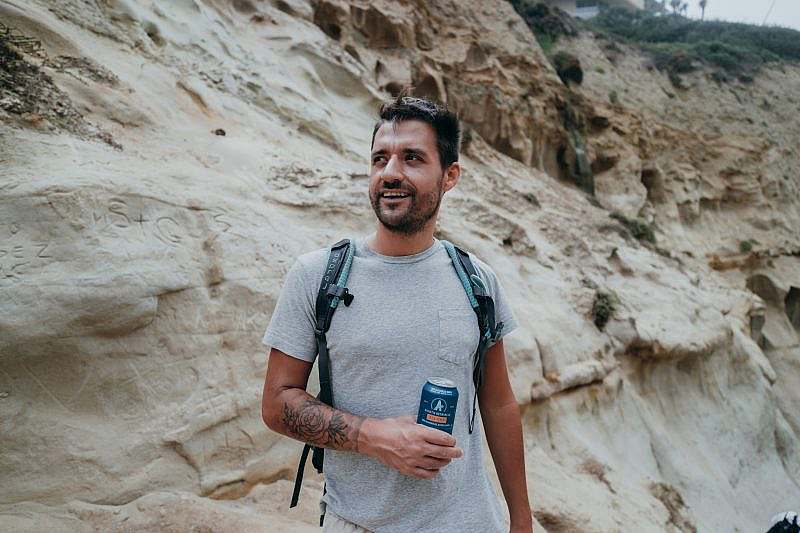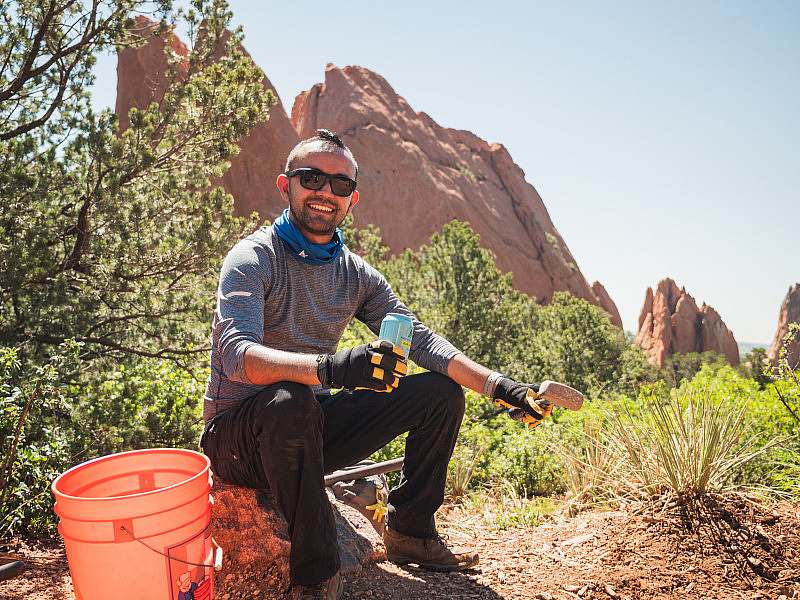Hiking is for anybody and everybody!
Warmer weather calls for adventure and we’ve got just the partner to accompany your excursions: Athletic Brewing. One of their favorite activities includes getting outside and giving back to Mother Nature.
We’re proud to be partnered with Athletic Brewing as our premiere beer sponsor for the American Hiking Society’s National Trails Day, so they put together this hiking guide for beginners to get you out on the trail!
Athletic Brewing believes that access to the outdoors is paramount for everyone’s health and wellbeing, which is why they started their Two for the Trails grant program. They want to see increased access to trail systems, no matter where you live. By pledging 2% of every sale, they were able to donate $1 million in 2021 alone to trail-based non-profits and IMPACT programs that are tirelessly working to protect outdoor spaces. Stay tuned for updates on their Two For the Trails grant program enrollment, their ode to the great outdoors!
In this beginner’s guide to hiking, they will share everything you need to know to get started. From how to pick a trail to gear recommendations to how to manage fears, they’ve got you covered. So snag an Athletic Lite and get ready for some fresh air.
What Are Some Different Types of Hiking?
Hiking is basically walking in nature on a surface that is not a road or a sidewalk. Hikes can be long or short, steep or flat, on paved trails or dirt trails. You can hike for multiple days or for only a few minutes. This variability is what makes hiking so great.
There are four types of hiking that you might hear people talk about. We’ve broken these down below:
Day Hiking – Day hiking is the most accessible form of hiking, and involves hikes that can be completed in one day. Distances for day hikes can vary based on your goals, experience level, time availability, comfort level, and walking speed.Backpacking – Backpacking involves carrying everything you need for multiple days in the wilderness. For this type of hiking, you would carry a large, specialized backpack with a sleeping bag, enough food for the duration of your trip, and other necessary gear for surviving outdoors for more than 24 hours. These trips can be as short as one night, or last for months.Fastpacking – Fastpacking is very similar to backpacking, except you cover much larger distances in a shorter amount of time. This style often involves jogging and carrying highly specialized ultra-lightweight gear.Thru-hiking – Thru-hiking is backpacking a long trail that starts and ends at different locations that may take weeks or months to complete. Popular thru-hikes are the Pacific Crest Trail and the Appalachian Trail.
For the sake of this blog, we are going to stick with day hiking.
Planning Your Hike
The biggest and most overwhelming barrier to entry is figuring out how to start planning your hike. As we say at American Hiking Society, “hiking begins before you reach the trailhead,” through planning appropriately.
How to Choose a Trail
The first step to planning your hike is to choose which trail you’re going to hike. Once you know the details of your chosen trail, such as the distance and elevation gain, you can start planning what to bring.
There are many great apps out there that help you find trails nearby. Many of these apps have a lot of the details laid out in an easy-to-read manner. We have a convenient and free web page that allows you to search for hikes near you. The hikes are rated based on difficulty, so you have a good idea of what you’re getting into. You can also purchase area-specific trail guides and books. As a beginner, choose trails that are well maintained and clearly marked until you feel more comfortable navigating.
Be sure to check if there are special permits needed for the hike. Some hikes, like Angel’s Landing in Zion National Park, require advance permits, some trails require that you pick up a free wilderness permit, and others don’t require any special permitting at all. Know these rules and regulations ahead of time so that you’re not turned away from your hike at the trailhead and so you don’t end up with a fine.
If you are very new to hiking, choosing a trail that is relatively short, with a lower total elevation gain is ideal. Starting small and working your way up to bigger and longer hikes is a great way to build confidence in the outdoors. Remember that hiking should always be enjoyable and manageable for your skill level.
Check Conditions
Depending on where your chosen trail is located, weather and trail conditions will factor into your decision-making process. Check the weather forecast in the area where you are planning to hike. Inclement weather may make for a less enjoyable (or downright miserable) time. Most new hikers find that Sunny days are the most enjoyable, but with experience, you may find hiking in the rain or snow has its own appeal. Checking the weather will also allow you to pack accordingly. Keep in mind that the weather can always change quickly, especially in the mountains.
You will also want to check to see what the condition of the trail itself is in. If your chosen trail is located in an area that receives a lot of snow, then there’s a good chance the trail will be snow-covered through the winter and possibly even the spring. Hiking snow-covered trails is not impossible, but it usually requires special gear. Make sure the trail and trailhead that you are planning to hike are open and clear.
If you are planning on visiting a State or National Park, you can check conditions by visiting the web page for the park. You can also check online forums and Facebook groups. Hiking aficionados will often write trip reports for the trails that they recently hiked, so an internet search can often reveal recent trail conditions.
What to Bring
Now that you know where you want to hike, it’s time to plan out what to bring with you. The first item you will need is a backpack. As you’re starting out, any backpack that you have laying around your house will do the job. However, once you’re hooked on hiking and you gain experience, you may want to invest in a more comfortable hiking-specific backpack for longer distances. These specialized packs are designed with pockets and straps to distribute weight more comfortably.
Once you have a backpack, it’s time to gather the necessary gear. A great place for any beginner hiker to start is with the list of 10 essentials. This gear list is comprised of 10 items that will help you stay safe and handle unexpected challenges that you may encounter during your time on the trail.

The list includes:
Navigation (GPS, map, compass)Extra clothing (rain gear, warm layers, etc)Extra food (beyond what you think you will eat during the hike)Extra water (more than you think you will consume during the hike)Sun protection (sunscreen, hat, etc)Headlamp (plus extra batteries)First aid kitKnifeFire (matches, lighter, etc.)Shelter (emergency bivvy)
Toast to the trails with a pack fit for adventure.
What to Wear
What you wear during your hike is specific to the weather that you may encounter. Dressing appropriately for the conditions is an important skill to foster. Good hiking clothing is moisture-wicking, meaning it draws sweat and moisture away from your skin and dries quickly. It’s important for your clothing to dry quickly for two reasons: it helps avoid skin discomfort, and wet clothing can make it difficult for you to regulate your core temperature. Avoid cotton and heavy materials, like denim, that hold on to moisture. Most hiking-appropriate clothing is made out of polyester, wool, or nylon.
Your clothing choice will depend on the temperature, season, weather forecast, duration of the hike, and your comfort. Remember that it’s always okay to bring extra layers.
Safety and Overcoming Fear
It’s totally natural to have some fears and concerns about safety when you take on a new hike. Whether it’s animals, getting lost, or your physical ability, we don’t want your fears to hold you back from trying hiking. More than likely, you are much safer than you think.
Hiking can be very safe when you plan accordingly. Carrying the right gear, wearing the correct clothing, and mapping your hiking route are all great places to start. You should also always let people know where you are hiking and when you plan on being back. Leave a map with people you trust that highlights the trails you plan to take, so they know exactly where to go looking.
Knowing your fitness ability is also an important factor in staying safe. Plan your hikes based on your current fitness level, not the level that you want to be at. Starting with smaller hikes and working your way up to bigger hikes is a great way to assess yourself. If your last hike felt fairly easy and comfortable, it’s likely a safe move to try a slightly more challenging hike next time. This will also help you experiment with elevation gain. A hike with 1000 feet of elevation gain may be easy for some, and very challenging for others. Remember that you can always turn around if your chosen trail feels too challenging.
Choosing a hike that is moderately trafficked or going with a friend that has some experience can help manage safety concerns and fear as well. You can also find hiking group meet-ups, or go on a guided hike.
Trail Etiquette
There are special trail etiquette principles that are helpful to know before setting out called Leave No Trace (LNT). Leave No Trace principles are guidelines that help everyone keep the outdoors clean, pristine, and enjoyable so that these wild spaces can be savored for generations to come.
You may be familiar with the adage, “Take only photographs, leave only footprints,” or, “Pack it in, pack it out.” These are important things to remember when you’re out in the wilderness. The idea is that you don’t take anything from the wilderness home with you, except memories, and you never leave trash behind, including fruit peels and cores.
Remember to be kind and respectful to other visitors and wildlife. Never approach or feed wild animals, keep voices and music low, and stay on marked trails and durable surfaces.
For more information on hiking etiquette, check out the guide over at the American Hiking Society.
Get Involved
As you fall in love with hiking and start discovering your favorite trails, a great next step is to get involved with the care and protection of the trails you adore. This could look like becoming an advocate and getting involved with local and federal organizations to protect the areas you love. It could also look like volunteering or organizing an event during National Trails Day. You can also find and volunteer with your local trail maintenance and development groups. The care and protection of our favorite spaces would not be possible without these trailblazers.
You can also keep an eye out for Athletic Brewing’s Two For The Trails grant, which opens April 22nd and runs until National Trails Day. They support organizations all over the country that are working hard to get hikers and outdoor enthusiasts more access to more trails. From the start, they’ve found their love for nature and activity goes with their love for brews. This year they will be giving $1 million to trail organizations around the country so if you are involved in an organization looking for funding for trail-based projects, apply!
Happy Hiking!

Read more :
- Climber Lily Bristow Risked Scandal to Pioneer New Ground
- The 8 Things You Should—No, Must—Do Before A Thru-Hike
- More Mystery Surrounding Mallory and Irvine and Everest’s First Ascent
- Alpinist and WWII Saboteur Freddie S. Chapman Was All Kinds of Badass
- Dahab Days: Climbing the Rock Playgrounds in Egypt’s South Sinai
- What Goes Into Naming a Mountain, Anyway?


2 comments
Greetings from Carolina! I’m bored at work so I decided to browse your website on my iphone during lunch break. I love the information you present here and can’t wait to take a look when I get home. I’m surprised at how quick your blog loaded on my mobile .. I’m not even using WIFI, just 3G .. Anyways, fantastic blog!
Hello.This article was extremely remarkable, particularly since I was searching for thoughts on this issue last Tuesday.